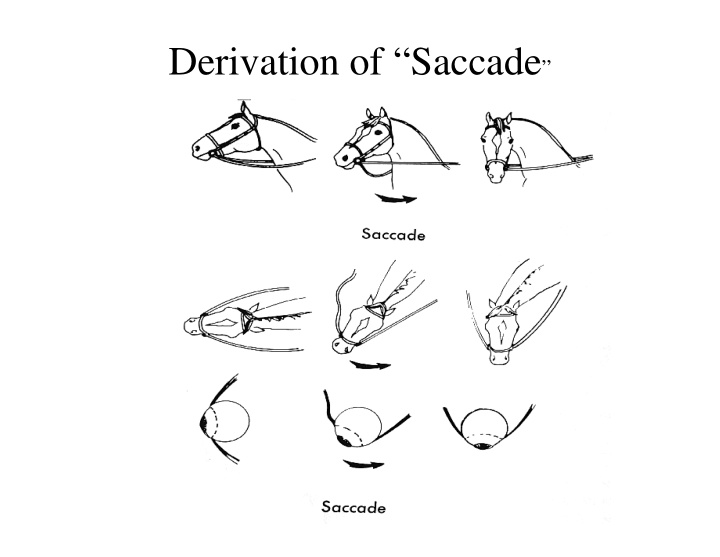



Derivation of “Saccade ”
Saccade Tasks
Visual Search Saccades
Micro-Fixation Saccades
Reading Gaze Shifts
Reading Gaze Shifts
Catch-up Saccades
Saccadic Fast Phase
Ballistic nature of saccades. Pulse and step are pre-programmed Latency = 250 msec Prediction can reduce saccade latency to zero.
Vision During Saccades is very reduced. Demo:Watch eye movements in a mirror Explination: Smearing of the retinal image Shearing of the retina Backward masking- second target erases the first
Saccades are characterized by their high velocity that comes at the cost additional force to needed to overcome muscle viscosity. Analogous to stealing second base in baseball. A pulse component of the saccade provides this extra force that is absorbed by the muscle. Pulse height sets velocity and width sets amplitude. A step component follows the pulse to hold the eye in its new position. This force counteracts the spring force of the antagonist.
Pulse and Step Innervation Agonist innervation Reciprocal innervation Antagonist innervation
Pulse-Slide-Step components of saccade generation Eye Position IR Motoneuron Time in msec Time in msec
Step innervation changes muscle stiffness maintains eye position Muscle innervation increases the spring constant (K) or muscle stiffness. This increases the restoring force applied to the eye and antagonist muscle.
Hooke’s Law: Force exerted by a spring equals the product of its length (L) and spring- stiffness constant (K) or elasticity. F = L x K Innervation increases the spring stiffness and force of the agonist against the antagonist. The length of the antagonist increases when stretched by the agonist until their forces become equal. Force exerted by the agonist and antagonist is smallest in primary position.
X 1 * K 1 = F = X 2 * K 2
X 1 * K 1 = F = X 2 * K 2
Burst Cell determine the velocity of a saccade Overcome viscosity to achieve high velocity Tonic cells maintain the new eye position at the end of a saccade Neural Integration transforms burst activity into tonic cell activity Pause Cell determine the duration of a saccade Triggers the burst cell activity like a car clutch
Pause, Burst and Integration circuit Pause Cell Burst Cell Oculomotor Neuron Eye position Neural Integration Pre-motor sites include PPRF and Prepositus for horizontal saccades & riMLF and nucleus of Cajal for vertical saccades
Brainstem Burst and Integrator regions V Integrator H Integrator V Burst H Burst
Brainstem burst and pause cell areas- Schematic
Amplitude of a saccade is determined by the duration and amplitude of the pulse.
Main sequence diagram plots velocity or duration as a function Of saccade amplitude. 10 deg saccade lasts 50 msec. Saccades are rarely longer than 100 msec Main sequence reflects the activity of Burst neurons.
Main Sequence Curve- peak velocity
Main Sequence Curve- Saccade duration
Supra-nuclear sites Frontal eye fields (Area 8) Superior Colliculus
Frontal Eye Fields
Cortical Projections
Saccade Pathways Schematic
Saccade amplitude abnormalities related to pulse and step Innervation Motor response Normal Saccade Hypometric Saccade Slow Saccade-Glissade Gaze-evoked Nystagmus (leaky integrator) Pulse-Step mismatch
Inappropriate Saccades Saccadic Oscillations- Dysmetria, Jerks and Flutter Dysmetria- (inaccurate size) Macrosaccadic Oscillations Square Wave Jerks Macro Square Wave Jerks Ocular Flutter
Parinaud’s Syndrome- no downward vertical saccades
Square Wave Jerks
Slow Saccades
Macro Saccadic Oscillations
Hypermetric Saccades
Adult Opsoclonus Movie
Infant Opsoclonus Movie
Spasmus Nutans
Saccade measured with coils and dual-Purkinje trackers Horizontal Vertical dual-Purkinje -> Degrees <- Coils <- Difference
ooo ooo o
Spasmus Nutans
Recommend
More recommend